Is your search for lighting that enhances your luxury interior still unfinished? Poor lighting can make even the most expensive designs feel cheap. COB LED downlights1 offer a clean, focused light to fix this.
COB (Chip-on-Board) LED downlights are favored in high-end homes because they produce a single, uniform beam of light. This avoids the multi-shadow effect of other LEDs, creating a cleaner, more luxurious ambiance. Their high color rendering also makes interior finishes look their absolute best.
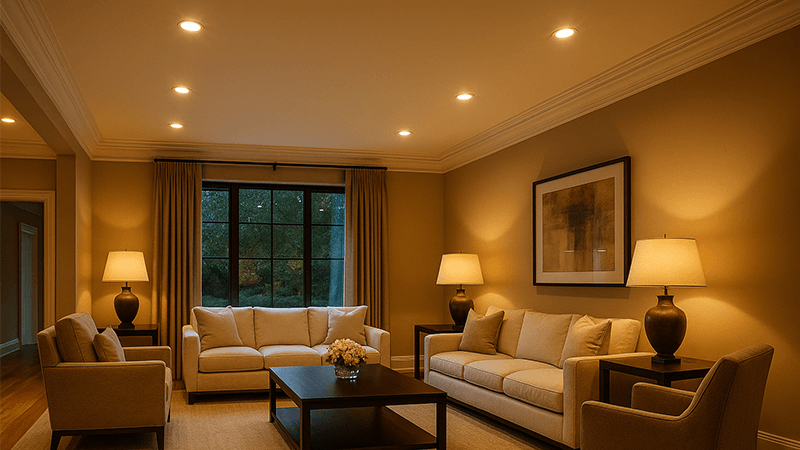
The choice of lighting can make or break a high-end project. As someone who has built a business on quality lighting, I've seen the difference firsthand. The technology behind the light is just as important as the fixture itself. Let's dig deeper into why COB technology has become the standard for designers and architects aiming for a premium finish. It's a small detail that has a huge impact on the final result.
What are the pros and cons of COB light?
You are considering COB lights but hear conflicting things. It is hard to know if they are really the best choice for your project. Making the wrong decision can lead to costly mistakes.
The main pros of COB lights are high light intensity2, a single clean beam, and superior color accuracy. The biggest con is their concentrated heat, which demands excellent heat management. They can also cost more upfront than standard SMD LEDs, but the quality is worth it.
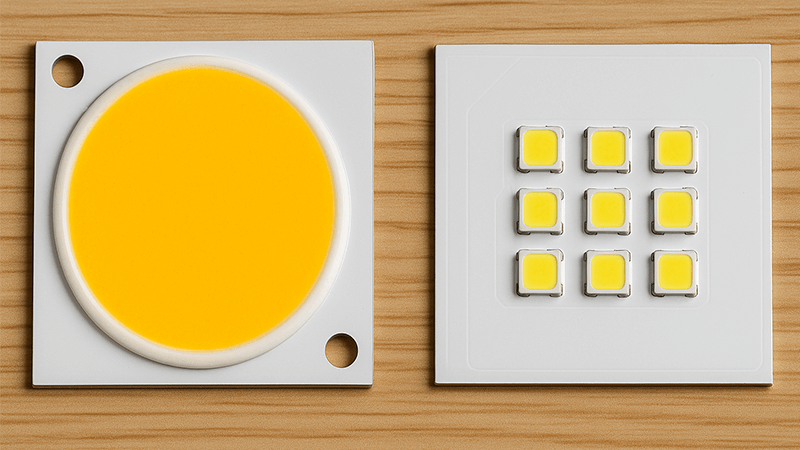
When I work with project managers like Shaz, we always weigh the pros and cons for their specific needs. COB technology isn't just a new trend; it's a fundamental step up in light quality, but you have to understand its characteristics to use it effectively. The main advantage is the light itself. A single COB chip contains many small LED diodes packed tightly together. This creates one point of light, just like a classic halogen bulb, but with all the efficiency of an LED. This single source eliminates the multiple, fuzzy shadows you can get from older LED types. For a minimalist, high-end design, this clean look is essential. However, all that power in a small area creates a lot of heat. This is the biggest challenge. Without a well-designed heat sink, usually made of quality aluminum, the chip will overheat and fail quickly. This is where I see many cheap products fall short. They look good for a few months, and then they start to fail. A quality COB downlight is an entire system designed for longevity.
Advantages vs. Disadvantages of COB Technology
To make it simple, let's break it down in a table. I always find this helps my clients see the full picture clearly.
| Feature | Pros (Advantages) | Cons (Disadvantages) |
|---|---|---|
| Light Quality | A single, clean point of light. No multiple shadows. High Color Rendering Index (CRI) makes colors look true and vibrant. | Can create very sharp, defined shadows, which may not be desired for all types of ambient lighting. |
| Intensity | High lumen density. It produces a very bright, powerful beam from a small surface area, perfect for high ceilings or accent lighting. | The intense brightness can cause glare if not properly shielded with a good reflector or anti-glare design. |
| Heat | The direct connection to the circuit board can offer a more efficient thermal path if designed correctly. | Heat is highly concentrated in a small area. It absolutely requires a high-quality, large heat sink to work reliably. |
| Cost | Over the long term, its efficiency and long lifespan can lead to cost savings. | The initial purchase price is often higher than older technologies like SMD due to more complex manufacturing. |
Is COB LED better?
Is COB just the latest trend, or is it truly better? You need to know if it offers a real advantage over other common LEDs, like SMD, for your specific projects.
COB LED is better for applications needing a high-quality, single-point light source, such as downlights and spotlights. SMD (Surface Mount Device) LEDs are better for wider, more diffused lighting like panels. For high-end residential downlights3, COB's clean aesthetic is almost always superior.
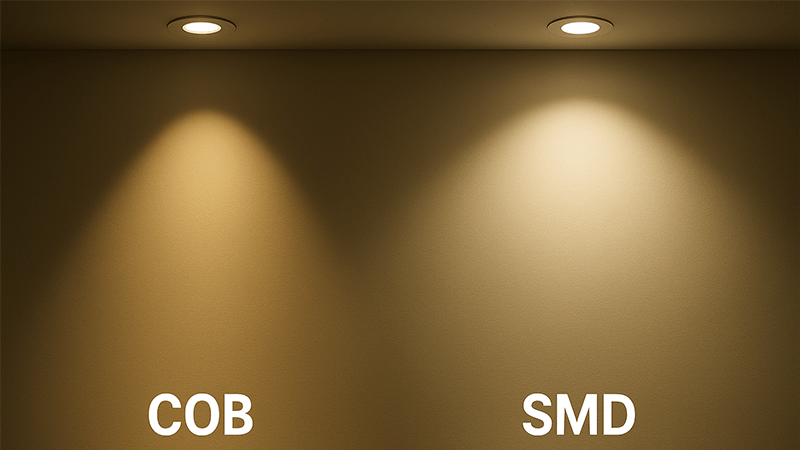
The question "is it better?" really depends on the job. I've helped hundreds of clients choose the right technology, and it always comes down to the application. You wouldn't use a hammer to turn a screw. In the same way, COB and SMD LEDs4 are both excellent tools, but they are designed for different tasks. The key difference is how the LED diodes are packaged. For high-end homes, the visual appearance of the light is critical. Think about lighting a valuable piece of art or a beautiful kitchen island. You want a single, crisp pool of light, not a cluster of small dots. This is where COB excels. Its structure mimics a traditional light source, which our eyes find more pleasing and natural. SMD LEDs, on the other hand, have their diodes spread out. This is fantastic for creating a wide, even glow in a panel light or a strip light, where you want to avoid any "hot spots." But when you put multiple SMD chips into a downlight, you see those multiple light sources, and it just doesn't deliver the same premium feel. So for the specific world of architectural downlights5, yes, COB is better.
COB vs. SMD: A Direct Comparison
Let's look at the core differences. This is what you need to know when sourcing products.
Light Source Appearance
The biggest selling point for COB in residential projects is its look. It produces a single, homogenous beam. When you look up at the ceiling, you see a clean, simple fixture that delivers beautiful light. It feels intentional and well-designed. An SMD downlight, without a heavy diffuser, often looks like a collection of tiny, bright dots. This can feel distracting and less sophisticated, taking away from the overall design of the room. This single-point source is why architects and designers specify COB for their most important projects.
Application Suitability
| Light Type | Best Use Case | Why it Works |
|---|---|---|
| COB LED | Downlights, Spotlights, Track Lights | Provides a powerful, controlled beam perfect for accenting features, task lighting, and rooms with high ceilings. |
| SMD LED | Panel Lights, Strip Lights, Light Bulbs | Creates wide, even illumination ideal for general ambient lighting where a diffused glow is needed. |
Efficiency and Reliability
Efficiency, measured in lumens per watt, is comparable between high-quality COB and SMD products. The real difference comes down to thermal management6 and overall build quality. As I mentioned, COB heat is concentrated. A well-built COB light will have a robust aluminum heat sink that pulls heat away from the chip, ensuring a long life. An SMD fixture spreads heat more easily, but in a poorly made product, any single SMD chip failing can affect the entire light. For me, reliability is everything. I always tell my partners to look at the construction of the heat sink first. It tells you a lot about the manufacturer's commitment to quality.
What are the common uses for COB lights?
You understand the tech, but where does it actually fit in a project? It is not always clear which fixture benefits most from a COB source. Using the right tech in the wrong place is a waste.
COB lights are commonly used in retail spotlights7, art gallery track lighting8, architectural downlights, and high-bay fixtures9. Their intense, focused beam is perfect for highlighting specific features, objects, or areas, making them ideal for both commercial and high-end residential projects.
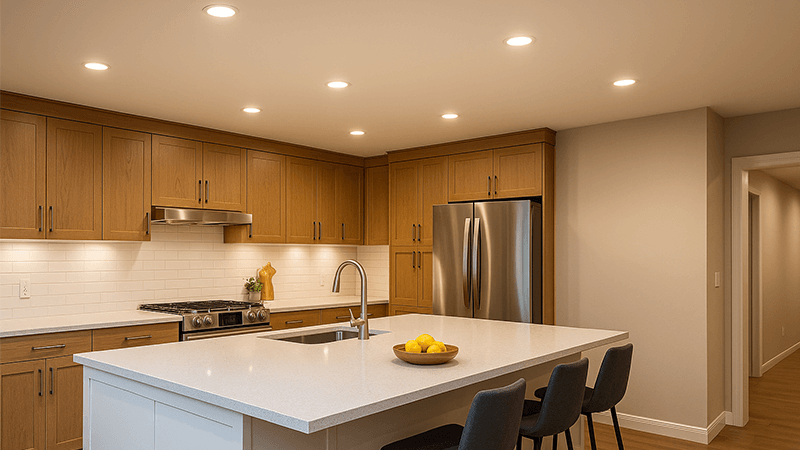
Thinking about the right application is key. A powerful tool is only useful if you know when to use it. I've designed and manufactured COB lighting for all kinds of environments, and they excel wherever you need control and punch in your lighting. In a home, this means creating layers of light. You might use other types of lights for general ambient light, but you bring in COB downlights and spotlights to create focus points. This is what gives a room depth and character. The same principle applies in a commercial setting. In a high-end store, you use COB spotlights to make a handbag or a piece of jewelry sparkle. In a restaurant, you use them to create an intimate pool of light over each table. The common thread is precision. COB lighting is for when you want to direct the eye and create a specific mood or highlight a specific feature. This level of control is exactly what high-end lighting design is all about. It’s not just about making a space bright; it’s about shaping the visual experience.
Practical Applications Breakdown
Let's get specific on where I've seen COB lights have the most impact.
Residential Applications
- Living Rooms: Perfect as adjustable "eyeball" downlights to highlight artwork on the walls or architectural details like a stone fireplace.
- Kitchens: A row of COB downlights over a kitchen island provides crisp, clear task lighting for food preparation. The high CRI makes food look fresh and appealing.
- Hallways: Used to create "wall washing," where the light grazes down a wall to showcase its texture, or to spotlight a console table at the end of a hall.
- Spaces with High Ceilings: In rooms with vaulted or two-story ceilings, you need the power of a COB light to push enough illumination down to the floor level.
Commercial Applications
- Retail & Showrooms: This is one of the biggest markets. COB spotlights with high CRI (95+) are essential to make colors on clothing look accurate and diamonds sparkle.
- Hospitality: In hotels and restaurants, they are used to create drama. A narrow-beam COB spotlight on each table in a dimly lit restaurant creates a sense of intimacy.
- Galleries & Museums: The clean beam and high CRI are perfect for illuminating artwork without harmful UV radiation. The light can be precisely shaped to fit the canvas.
In all these uses, power stability10 is critical. Especially in commercial buildings, power grids can have frequent surges. I've seen entire projects with cheaper products fail in batches. That is why I always insist that the power supplies, or drivers, have surge protection of at least 2kV. A premium COB chip is nothing without a reliable driver powering it.
Which downlights are best for home?
Choosing the perfect downlight for a home can be confusing. There are so many options. You want something that looks great, feels right, and works reliably for years. The wrong choice is a constant headache.
The best downlights for a home are COB LED models with a high CRI (90+), the right color temperature for the room's mood, and an appropriate beam angle11. For general lighting, a wider beam is good. For accenting features, a narrower beam is better.
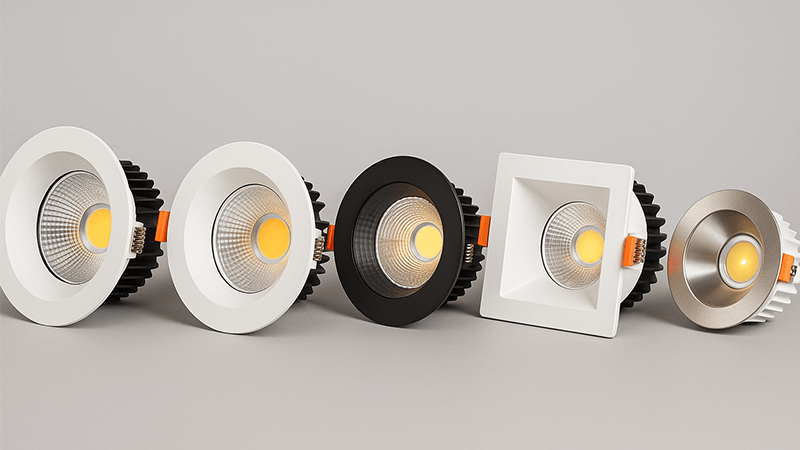
There is no single "best" downlight for every home. The best downlight is the one that is picked correctly for its specific job. When I consult with a client like Shaz, who is purchasing for large projects, we don't just talk about the product. We talk about the space. Is it a cozy bedroom or a functional home office? Does the client want to highlight a collection of art or provide general light for a playroom? Helping a customer navigate these choices is a huge part of what we do. The technology gives us amazing tools, but the expertise is in knowing how to use them. A high-end home deserves a custom-tailored lighting plan, and that starts with choosing the right specifications for every single downlight. It's about more than just brightness; it's about creating the right feeling and making the home a comfortable, beautiful place to live. That's what great lighting is all about.
Key Factors for Choosing Home Downlights
To select the right downlight, you need to think like a designer. Here are the four things I always tell my clients to focus on.
1. Color Rendering Index (CRI)
This measures how accurately a light source reveals the true colors of objects. For a home, you should never accept anything less than a CRI of 90. A high CRI makes wood floors look rich, paint colors look correct, and even the food on your plate look more appetizing. It's a non-negotiable feature for quality lighting.
2. Color Temperature (CCT)
This is the "color" of the white light, measured in Kelvin (K). It sets the mood of the room.
| CCT Value | Description | Best For |
|---|---|---|
| 2700K | Warm & Cozy | Bedrooms, living rooms, creating a relaxing, intimate feel like an old incandescent bulb. |
| 3000K | Soft Warm White | Kitchens, bathrooms, all-purpose areas. It's a clean, inviting light that's very popular. |
| 4000K | Neutral White | Home offices, garages, laundry rooms. Good for task-oriented spaces where you need to be alert. |
3. Beam Angle
This determines the size of the pool of light on the floor.
- Narrow (15°-24°): Use this for dramatic accent lighting on a small sculpture or a floral arrangement.
- Medium (36°-40°): A great all-purpose beam. Perfect for task lighting over counters or for general lighting when spaced correctly.
- Wide (60°+): Good for broad, ambient lighting in a large room where you want to wash the entire space in soft, even light.
4. Dimming
In a high-end home, the ability to dim your lights is essential. It allows you to change the ambiance from bright and functional to low and moody. Always check that the downlight and its driver are compatible with the type of dimming system being installed (e.g., Triac, 0-10V). Smooth, flicker-free dimming is a sign of a quality product.
Conclusion
COB downlights are the top choice for high-end homes because their single light source and high color accuracy12 provide a clean, luxurious look. Success depends on quality components and proper specifications.
Explore the advantages of COB LED downlights for luxury interiors and how they enhance ambiance. ↩
Learn about light intensity and its impact on the effectiveness of lighting design. ↩
Explore the top choices for downlights that elevate high-end residential interiors. ↩
Understand the differences between SMD and COB LEDs for informed lighting choices. ↩
Learn about the applications and benefits of architectural downlights in design. ↩
Explore the importance of thermal management for the reliability of LED lights. ↩
Discover how effective lighting can transform retail spaces and highlight products. ↩
Explore the best practices for lighting art galleries to enhance artwork visibility. ↩
Learn about high-bay fixtures and their applications in commercial settings. ↩
Understand the importance of power stability for the reliability of lighting installations. ↩
Discover how beam angle influences the distribution and effectiveness of light. ↩
Discover why color accuracy is essential for showcasing art and interior design. ↩

